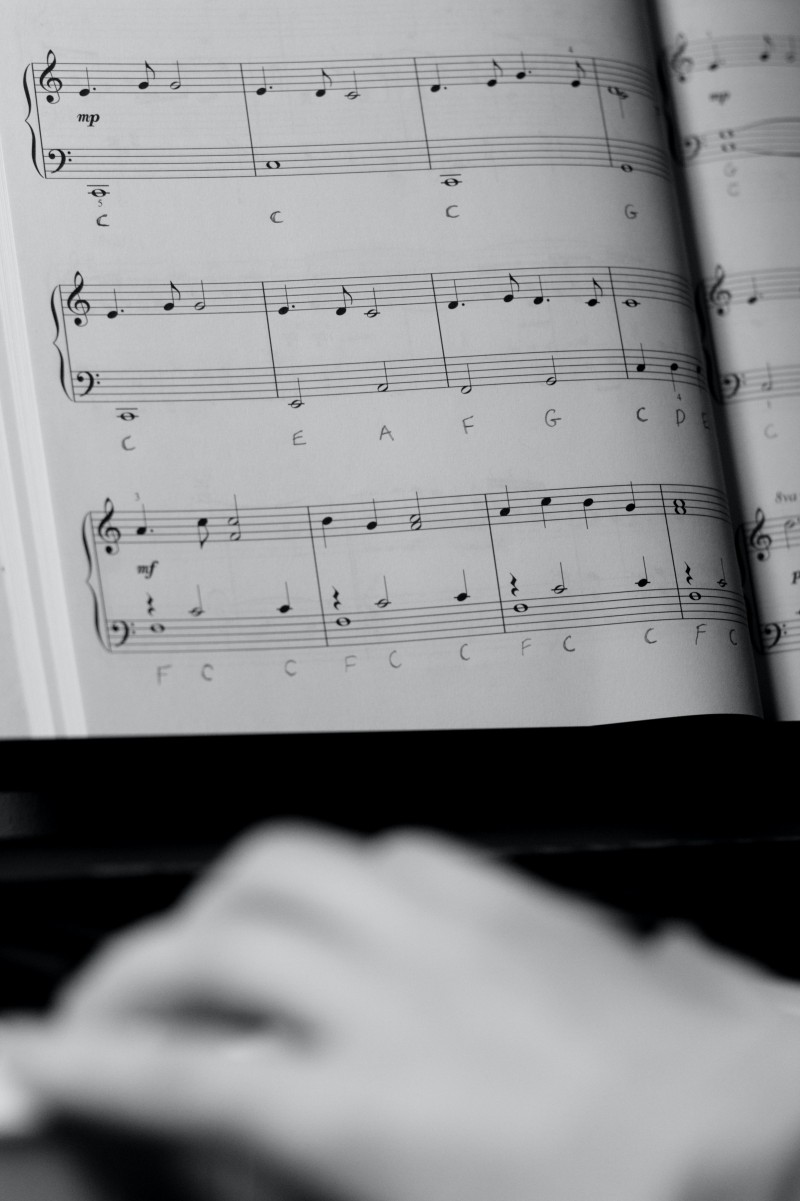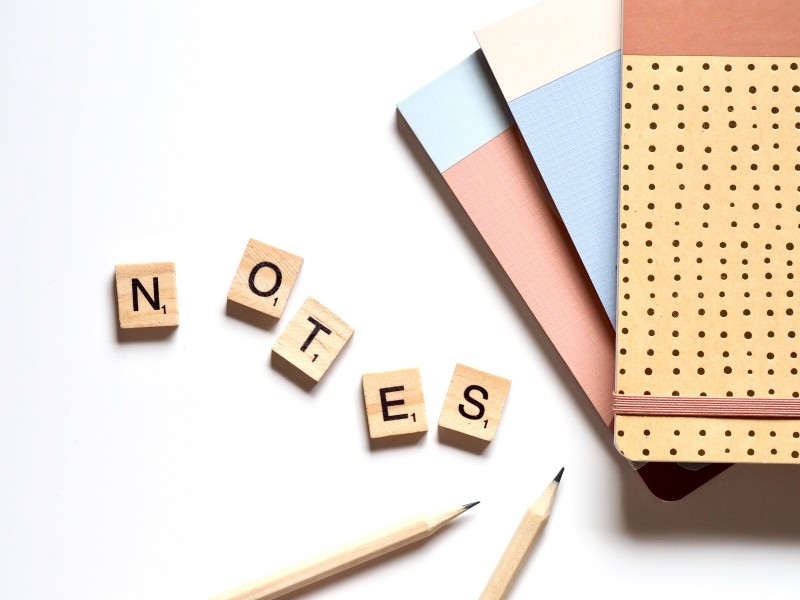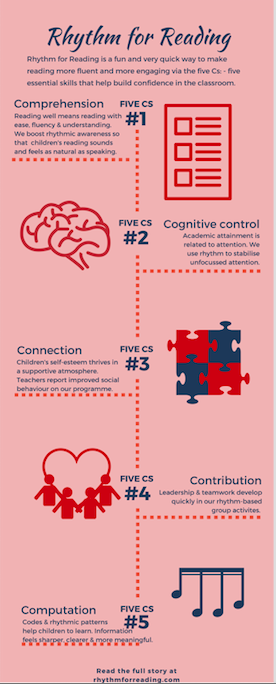The Rhythm for Reading blog
All posts tagged 'fluency'
Empowering children to read musical notation fluently
4 November 2022
Schools face significant challenges in deciding how best to introduce musical notation into their curriculum. Resources are already stretched. Some pupils are already under strain because they struggle with reading in the core curriculum. The big question is how to integrate musical notation into curriculum planning in a way that empowers not only the children, but also the teachers.
The tried and tested ways of teaching musical notation are best suited to pupils who process information with ease. Traditionally, piano teachers begin with mnemonics for the notes that sit on the lines of the stave EGBDF (Every Good Boy Deserves Favour) GBDFA (Good Boys Deserve Fun Always) and for the notes that sit on the spaces FACE (Face) and ACEG (All Cows Eat Grass). Many teachers use these mnemonics to introduce a series of line notes and / or space notes all at once, which creates a heavy cognitive load.
What about all the children who struggle to process information, reading with ease and fluency?
Well-intentioned efforts to adapt musical notation for children who struggle to process the mnemonics, involve adding more information and increasing the cognitive load.
What is going on here?
Music teachers want children to enjoy making music and to have fun producing sounds on their instruments and they hope that in time, reading notation will gradually become familiar and easier to read. Until that point, music teachers add extra information to remind the child of the letter names of the notes. In the same vein, they often add numbers representing the finger patterns, to remind the child how to produce sounds on the instrument.
Soon enough, the page is cluttered with markings and the child has to select which ones to read.
These markings are intended as a quick fix, aiming to keep the child engaged. But of course the child relies on the letters, or the numbers, or both instead of reading the actual notes. This approach sets the child up to fail in the sense that they do not learn to read notation at all and even worse, assume that it is too difficult for them.
What could teachers do differently to support children who do not process information with ease and fluency?
A more inclusive approach would limit the cognitive load on children’s reading - which is what we do in the Rhythm for Reading Programme. Rather than teaching all the notes at once, we focus on just a few notes and develop fluency (and fun) in reading right from the start. Instead of learning the musical notes at the same time as playing musical instruments, which adds to the cognitive load, we simply use our feet, our hands and our voices, as we believe these are our most natural musical instruments.
Group learning in a structured programme supports the development of fluency, because the children are nurtured by the ethos of working together. Teamwork in combination with rhythm is an effective way to build fluency in reading, and acts as a catalyst for accelerated progress.
Fluency, Phonics and Musical Notes
26 September 2022
The phonics wars raged back in the days leading up to the publication of the 2006 Rose Review. The value of synthetic versus analytical phonics was one of the key educational debates of the decade. At that time, the fragile readers that I was working with as part of my PhD, struggled to decode a simple C-V-C word (consonant-vowel-consonant) such as ‘cat’. I was glad that, following the publication of the Rose review all children would be taught systematically to recognise letter-to-sound correspondence, as well as being explicitly taught to recognise the smallest sounds of language. It was unacceptable to me at that time that the phonemes of simple three letter word such as ‘c-a-t’ were a new discovery for vulnerable children at nine years of age.
Below the radar of the mainstream media, music educators were digging deeply into their own entrenched positions around the teaching of musical notation. Unfortunately, these ideologies and their false narratives have limited access to the development of important musical skills and musical knowledge. Decoding musical notes (like any other form of reading) opens up access to participation in a multicultural global community. In the case of music, this community consists of performers, listeners, arrangers, publishers and composers, who engage across ever-expanding musical genres, including sound tracks for video games, film and television. Music educators’ ideologies have limited access to creative opportunities for too long.
Most children start school with thousands of words and hundreds of melodies in their heads. Yet, in schools and music studios, one of the most limiting and perhaps most misunderstood ideologies stemming from high profile music educators, is that of ‘sound before symbol’. Music teachers have been told for decades that best practice involves singing and naming the shapes of tunes using doh, re, mi. Only when the tune has been learned ‘by ear’, are the visual symbols introduced. The idea that a sound must be taught before introducing a symbol to represent it, has a certain logic, but sound does not need to be taught in this way because sound is processed incredibly rapidly in the auditory system and was the first of our sensory processing systems to reach full maturity in utero.
Ofsted’s July 2022 publication supports moving away from the principle of sound before symbol and recommends a stronger commitment to the teaching of musical notation as a part of a broad and balanced curriculum. In the teaching of reading, automated phoneme-to-grapheme correspondence is the key to the rapid development of fluency. Indeed this usually involves presenting the sound with the symbol using rapid response multi-sensory teaching methods. In the Rhythm for Reading programme, we teach sound with symbol correspondence using a rapid response multi-sensory approach to musical notation and therefore prioritise fluency as the overriding goal.
Get in touch by visiting the contacts page if you would like to boost reading fluency in a ten-week period and gain the additional benefit of teaching every child to read musical notation fluently in the very first session of the programme.
Reading fluency and comprehension in 2020
9 November 2020
A strong correlation exists between reading fluency and comprehension - one that has fascinated researchers for many decades (Long, 2014). In our current climate, children who read fluently are more likely to cope well with blended learning, self-isolation and other restrictions of the global pandemic on schools.
How can we move more children into the fluent reader category?
Proficient readers automatically use the most appropriate strategy on the fly, whereas fragile readers are more likely to depend on a single strategy and to transition less efficiently from one strategy to another. A fluent reader however, is able to decode an unfamiliar word using phonological skills, as well as orchestrating contextual and syntactic cues to decode whole phrases.
So, there are many processes that are coordinated during fluent reading. Reading comprehension is a cornerstone of these. However, comprehension is not a ‘layer’ of reading that magically ‘appears’ because it has been mechanically underpinned by good levels of decoding and fluency. Comprehension is a product of rhythmic awareness - an important element of language acquisition in infancy.
Though well-intentioned, the practise of timing children’s reading with a stopwatch, encouraging them to read more quickly week after week is not helpful for cultivating rhythmic awareness. Using a stopwatch may generate a degree of motivation to read, but a focus on acceleration forces the child to read without finding their natural rhythm. In fact, if children have learned to decode at a fast pace, they have been trained to enunciate the words without understanding them at all. Comprehension is not related to the pace of reading.
Comprehension and word recognition are coordinated by rhythmic processes during fluent reading that are similar to the natural unfolding of rhythm during speaking and listening. A rhythm-based approach fosters rhythmic awareness and supports fluent reading.
Long, M. (2014). ‘I can read further and there’s more meaning while I read’: An exploratory study investigating the impact of a rhythm-based music intervention on children’s reading. Research Studies in Music Education, 36(1), 107-124.
Rhythm and Reading Comprehension 1/5
29 April 2018
‘To be understood - as to understand’ from the prayer of St Francis captures a profound truth: we are at our happiest when we feel truly understood by others. This feeling of mutual understanding strengthens communities and generates an aura of certainty at the core of each individual’s character. The ability to understand exists in all of us, but can easily be obscured by doubt, worry or fear. Removing worries, doubts and fears leads to clarity –as Johnny Nash put it, “I can see clearly now the rain has gone…”. The same principle applies to reading comprehension. The songlike qualities of speech (i.e. prosody) come to life in children’s voices when they are able to read with ease, fluency and understanding.
In the Simple View of Reading, reading comprehension is described as the ‘product of’ skilled decoding and linguistic comprehension (Gough & Tumner, 1986). The recent focus on oracy (for example Barton, 2018) highlights a focus in some schools on linguistic comprehension. According to researchers, the proportion of children beginning school with speech, language and communication needs is estimated at between 7 and 20 per cent (McKean, 2017) and unfortunately, communication issues carry a risk of low self-esteem and problems with self-confidence (Dockerall et al., 2017).
In the Gough & Tunmer model, the term ‘product of’ seems a little vague. I like to think that ‘product of’ refers to the flexible quality found in skilled reading as well as the dynamic integration of natural language with the alphabetic code. At first, beginning readers struggle to accommodate words and sentences of a variety of shapes and lengths, but as they become more skilled, they ease into a state of flexible, responsive reading, which leads to being able to read sentences whilst processing meaning at the same time. What is even more remarkable about this process is that reading with this wonderful flexibility takes place within distinct time constraints.
The time constraints are a kind of rhythmic signature for language comprehension as well as music and are biologically determined (Long, 2006). Each and every line of a song, poem or musical phrase typically lasts for 3-5 seconds. This brief ‘window’ is our subjective sense of the present moment (Gerstner & Fazio, 1995). In a song, a poem or a musical phrase, this moment is packed with messages and meanings – relating information about feeling, being or doing. The rhythm of reading in any language is very flexible indeed, but it is underpinned by this constant ebb and flow of units of meaning every 3-5 seconds. Becoming aligned with this natural flow of meaning helps children to read words, phrases and sentences with ease, fluency and understanding and also to anticipate words and phrases prior to reading them.
The importance of this rhythmic ebb and flow of meaning cannot be overstated and is a core part of the Rhythm for Reading programme. The programme uses music rather than words to develop rhythmic sensitivity, so it is suitable for children and young people who need a sharp ‘boost’ in reading comprehension, language and communication skills, phonological awareness or cognitive control, whether attending mainstream or special schools.
Barton, G “Teachers should encourage pupils to speak up – and should remember to do so themselves TES News https://www.tes.com/news/teachers-should-encourage-students-speak-and-remember-do-so-themselves Retrieved on 29.4.2018
Dockrell, Julie Elizabeth, et al. “Children with Speech Language and Communication Needs in England: Challenges for Practice.” Frontiers in Education. Vol. 2. Frontiers, 2017.
Gerstner, Geoffrey E., and Victoria A. Fazio. “Evidence of a universal perceptual unit in mammals.” Ethology 101.2 (1995): 89-100.
Gough, Philip B., and William E. Tunmer. “Decoding, reading, and reading disability.” Remedial and special education 7.1 (1986): 6-10.
Long, M. “Stamping, clapping and chanting: An ancient learning pathway?” Educate Journal, 3, 1, (2006) 11-25
McKean, Cristina, et al. “Language Outcomes at 7 Years: Early Predictors and Co-Occurring Difficulties.” Pediatrics(2017): e20161684.
Catch-Up and Catch-22
14 April 2018
Academic achievement relates strongly and reciprocally to academic self-concept, for example in English and Maths (Schunk & Pajares, 2009) and also reading (Chapman & Tumner, 1995); moreover the importance of motivation increases as perceptions of reading difficulty increase (Klauda et al., 2015). So reading catch-up can also feel as if it’s a catch-22 situation. To resolve this issue, Hattie (2008) recommended that teachers teach self-regulating and self control strategies to students with a weak academic self-concept: ‘address non-supportive self-strategies before attempting to enhance achievement directly’ (Hattie, 2008; p.47).
Peeling back the layers on the self-concept literature, various models and analogies are available (Schunk, 2012). Hattie’s highly effective analogy of a rope captures rather vividly the idea of the congruence of the core self-concept as well as the multidimensionality of intertwining fibres and strands that are accumulated via everyday experiences (2008, p.46). The rope image supports the idea that a particular strand applies to maths, whereas a completely different strand applies to reading and another one for playing football and so on.
The relationship between self-concept and academic achievement is reciprocal (Hattie, 2008) and also specific to each domain (Schunk,2012). Therefore, strengthening self-concept for reading supports achievement in reading, while strengthening self-concept for maths supports maths skills. It is very difficult to strengthen low self-concept in a specific domain before addressing achievement in that area, unless introducing a completely new approach. It is important that the new approach supports self-strategies as well as directly building strength in domain-relevant skills. The Rhythm for Reading programme meets both of these requirements.
Rhythm for Reading works as a catalyst for confidence and reading skills and therefore lifts a negative reciprocal relationship (catch-22 situation) into a positive cycle of confidence and progression. This programme is effective as a reading catch-up intervention because it offers a fresh and dynamic approach, which perfectly complements to traditional methods. Instead of reading letters and words, pupils read simplified musical notation for ten minutes per week. Consequently, they are practising skills in decoding, reading from left-to-right, chunking small units into larger units, maintaining focus and learning, as well as developing confidence, self-regulation and metacognitive strategies all the while.
The musical materials used in the Rhythm for Reading programme have been specially written to be age-appropriate and to secure pupils’ attention, making the effortful part of reading much easier than usual. In fact, throughout the programme, the cognitive load for reading simple music notation is far lighter than for reading printed language, enabling an experience of sustained fluency and deeper engagement to be the main priority. As these case-studies show, this highly-structured approach has had huge successes for low and middle attaining pupils, who were able to read with far greater ease, fluency, confidence and understanding after only 100 minutes (ten minutes per week for ten weeks).
Chapman, J. W., & Tunmer, W. E. (1995). Development of young children’s reading self-concepts: An examination of emerging subcomponents and their relationship with reading achievement. Journal of Educational Psychology, 87, 154–167.
Hattie, J. (1992). Self-concept. Hillsdale, NJ: Erlbaum.
Hattie, John.(2008) Visible Learning: A Synthesis of Over 800 Meta-Analyses Relating to Achievement. Routledge.
Klauda, Susan Lutz, and John T. Guthrie. “Comparing relations of motivation, engagement, and achievement among struggling and advanced adolescent readers.” Reading and writing 28.2 (2015): 239-269.
Pintrich, P.R. and Schunk, D.H. (2002). Motivation in education: Theory research and applications (2nd edition) Upper Saddle River, NJ: Merrill.
Rogers, C.R. (1959). A theory of therapy, personality, inter-relationships as developed in the client-centered-framework. In S. Kock (Ed) Psychology: A study of a science, Vol.3, pp.184-256 New York, McGraw-Hill.
Schunk, D. H. and Pajares, F. (2009). Self-efficacy theory. In K. r. Wentzel & A. Wigfield (Eds.), Handbook of motivation at school (pp. 35-53). New York:Routledge.
Schunk, D.H. (2012) Learning theories: An educational perspective, 6th edition, First published 1991 Boston: Allyn & Bacon, Pearson Education Inc.
Statistically significant impact after only 100 minutes
1 March 2018People are usually intrigued when I explain that this reading programme requires only 100 minutes from start to finish. In fact, pupils do not necessarily need 100 minutes to accomplish the goals of the Rhythm for Reading programme. Often improved engagement, comprehension, ease, fluency and joy of reading can be achieved after one hour spread across six weeks. A six week programme works well for the majority of children but for some who unfortunately do not attend school consistently, it would be far too easy for them to fall behind. By simply increasing the total length of the Rhythm for Reading programme from 60 to 100 minutes, all the children have enough time to develop their rhythmic awareness and experience the benefits in their reading. When 100 minutes are spread across ten weekly sessions, the programme slots neatly into a school term and this is convenient for everyone.
I am often asked how it’s possible for pupils to make real progress in only ten minutes per week and how certain can we be that the impact is attributable to Rhythm for Reading? These are excellent questions. First of all, pupils are reading everyday in the classroom, so they have ample opportunity to apply the rhythm-based approaches that they learn in the weekly ten-minute sessions to every task that involves reading during the school day. Each ten-minute session acts as a powerful catalyst, aligning decoding skills with the natural language processing abilities of the pupils. As the approach is rhythm-based instead of word-based, pupils with specific learning difficulties such as dyslexia or English as an Additional Language (EAL) benefit hugely from the opportunity to improve their reading without using words. It’s an opportunity to lighten the cognitive load, but to intensify precision and finesse. Secondly, I made sure that Rhythm for Reading was among the first intervention programmes to be evaluated as part of the EEF initiative. In this trial, I chose not to exclude any pupils. This meant that some students that took part were unable to access the reading tests because they could not decode text at all. The randomised controlled trial showed scientifically that improved reading scores were attributable to participation in the Rhythm for Reading programme, even though it took only 100 minutes to complete.
Progressive action in schools
25 June 2017
The recent tragic events in London and Manchester have been deeply painful and have also been a sharp reminder of the importance of taking progressive action in education. In 2012, I embarked on an entrepreneurial journey because I wanted the benefits of rhythm-based learning to be available in classrooms everywhere, as well as to ensure that certain educational advantages that are available to the privileged who can afford high quality instrumental music tuition would be, in a condensed and concentrated format, available to all. We hear frequently about the importance of reading for the development of empathy, and in 2014, I decided to create a project which would combine the theme of empathy with rhythm-based activities, which enhance social cohesion, reading fluency, reading comprehension and engagement. With the help and support of the senior leadership teams of two neighbouring, but very different schools, Alleyn’s, an independent school, and Goodrich Community Primary School, we have established a bond based on empathy, cooperation, rhythm and reading.
The project has completed eight cycles so far. Each week a group of assured and enthusiastic Year12 Alleyn’s students have accompanied me to Goodrich School, where they have mentored wonderfully effervescent pupils in Year 3 and Year 4. Everybody benefits profoundly from taking part: the mentoring students quickly learn to build trust and communication with the younger children, who experience a remarkable transformation in their reading. I am very much looking forward to presenting on this topic on Saturday 1st July at the UKLA 53rd International Conference 2017 ‘Language, literacy and class: Connections and contradictions’ at Strathclyde University, Glasgow.
Discover the heartbeat of reading
7 January 2017BETT 2017 is just around the corner! In a few weeks, Rhythm for Reading will be taking part in The Great British Trail in partnership with the Department for International Trade (Stand D30). We will be sharing our ideas and vision with visitors using audio and video clips and other goodies. We’ll be on stand C62 and look forward to saying hello.
The Rhythm for Reading programme helps teachers and students to activate the rhythmic aspect of reading, which researchers are discovering is so important for building reading fluency and understanding.
Why not think of rhythm as the heartbeat of reading?
Just as a heartbeat is dynamic, adjusting to our every need, rhythm in reading is the adjustable quality that provides strength, responsiveness and flexibility as sentences of all shapes and sizes flow through the text.
Just as a heartbeat is organic, supporting life in each part of the body from the smallest cells to the largest organs, rhythm in reading reaches systemically into every part of language. Like a heartbeat it spreads both upwards, supporting the structure of phrases and sentences and also downwards, energising and sharpening the edges of syllables and phonemes. Rhythm therefore brings the different grain sizes of language into alignment with each other.
Sensitivity to the rhythmic cues in printed language can be developed very easily. In fact, we already use rhythm in everyday life to coordinate activities that we take for granted such as walking, talking and obviously, in our breathing. However, as reading is a socially learned activity, the rhythmic quality that is naturally present in language processing does not always map with ease onto decoding skills. This is why for some children reading does not become increasingly skilled over time, even when decoding skills are secure. Fortunately, sensitivity to rhythm in reading can be improved very quickly as these case studies show.
Look out for the next post in this series on rhythm at the heart of reading.

